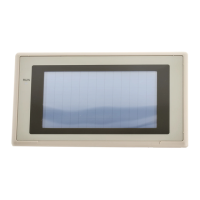3-10SectionDisplay and Setting of Calendar Clock
361
Program Operation
When the program is executed after displaying the created screen on the PT, the
operation is controlled as follows:
1, 2, 3... 1. When bit 00000 comes ON, the date and time (AR 18 to AR 21) set in the PC
is read, and written to words (DM0000 to DM0003) allocated for numeral
memory table entries 264 and 265.
2. The contents in numeral memory table entry 264 (day, hour, minute, se-
cond) are copied to numeral memory table entry 254, which is used for set-
ting the clock function.
3. After waiting about a second for the completion of the memory table copy
operation in step (2), the memory table copy execution bit (10303) is re-
turned to the OFF status.
4. After a wait of about one second for the PT to confirm that the memory table
copy execution bit has gone OFF, the program copies the contents of nu-
meral memory table entry 265 (day of the week, year, month) to numeral
memory table entry 255, which is used for setting the clock function, in the
same way as described in steps (2) and (3) above.
The date and time set at the PC is set for the PT and displayed.
Reference: Only the last two digits of the year are displayed. If all four digits of the year
need to be display, append the first two fixed characters to the PC’s variable
year digits year as required (19).
The structure of the clock data in the NT21 is the same as the structure of the
words containing the clock data in the CS/CJ-series and C-series PCs. If these
words are allocated for the Clock Data Area with the NT21, then the clock data
will be automatically synchronized during operation if the words are allocated.

